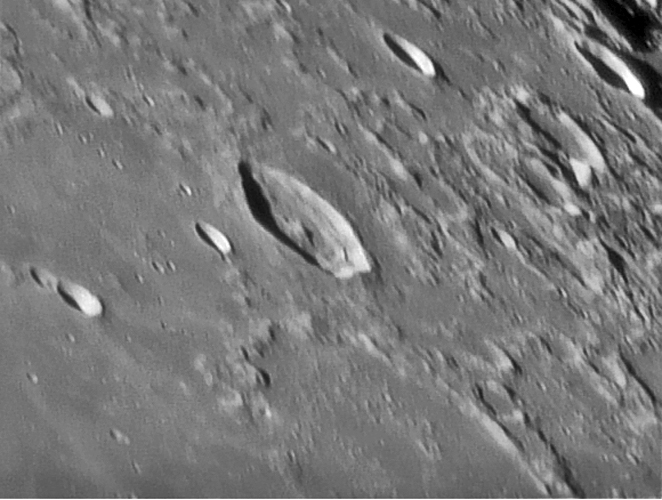April 12, 2008
A Fundamental Characterization

image by Francois.Emond
Last year an LPOD pointed out a number of craters whose prior estimates of depth differed greatly. Here is another example - the crater Democritus is a frequently overlooked complex crater just north of eastern Mare Frigoris. As summarized in The Moon Wiki, Democritus has two reported depths: 4.3 km from Westfall and 1.95 km according to Viscardy. Neither of these authors explain how their depths were obtained. It is likely that Viscardy's value is from the LAC 13 chart which has exactly that number. Fortunately, Francois provides the date and time of his image so that anyone carefully using LTVT can determine the depth from measures on this and other images. Does is matter what the correct depth is for Democritus? Yes, if we want to understand the depth (d) to diameter (D) ratio for lunar impacts and why it varies. Some years ago Mark Cintala and I discovered that the d-D ratio was different for craters on highland compared to those on mare, probably because of the differences in strength of those two target rocks. Although the difference was small (only 5-10% as i recall) it was statistically significant. Democritus and a lot of other craters occur of basin ejecta - how does that compare to impacts on pure mare or pure highlands? So what is the actual depth of this 39 km wide crater?
Chuck Wood
Technical Details
01/08/07, 02h55 UT. Dobson T400 + barlow FFC + extension tubes + Webcam Vesta Pro N & B mode raw + red filter RG630. Processing with Iris.
Related Links
Francois' website
Yesterday's LPOD: Low Sun, High Drama
Tomorrow's LPOD: Streamers
COMMENTS
(1) Presumably Kaguya will return a definitive profile before too long; but even then there is a certain element of arbitrariness in assigning a single value for a crater depth since rims are seldom perfectly uniform in their height above the floor. While awaiting the Kaguya results, the shadows in LO-IV-080H (the Wiki "mugshot") do a pretty good job of establishing a profile of the east rim of Democritus. It appears to range from about 2400 to 3000 m above the floor (the high point being in the SE). Francois' image (assuming "01/08/07" means August 1, 2007). suggests a very similar range of heights for the west rim. 3.0 km would seem a good "depth", then, if the maximum is meant. The shadows in the many Consolidated Lunar Atlas plates are quite consistent with the values quoted here; so Viscardy's 1.95 km seems too small, and Westfall's 4.3 km too large. By the way, the average diameter is closer to 37 km than 39, the central peak is about 1 km high, and the rim appears to rise above the surrounding terrain by about the same amount.
-- Jim Mosher
(2) Thanks, Jim! This is an excellent illustration of how amateurs can use LTVT to characterize the fundamental properties of lunar craters - there have to be good measurements to base theories on. As to what to consider a crater's depth: Making shadow measurements on Lunar Orbiter IV 30 yrs ago we determined the maximum depth, but Dick Pike in his measurements on the high res orthotopomaps determined the average depth for 6-8 measures around the rim. Either of those is better than the grossly wrong measures we previously had for Democritus and many other craters and peaks.
Chuck
COMMENTS?
Register, Log in, and join in the comments.



